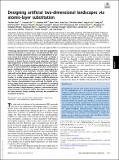Designing artificial two-dimensional landscapes via atomic-layer substitution
Author(s)
Guo, Yunfan; Lin, Yuxuan; Xie, Kaichen; Yuan, Biao; Zhu, Jiadi; Shen, Pin-Chun; Lu, Ang-Yu; Su, Cong; Shi, Enzheng; Zhang, Kunyan; HuangFu, Changan; Xu, Haowei; Cai, Zhengyang; Park, Ji-Hoon; Ji, Qingqing; Wang, Jiangtao; Dai, Xiaochuan; Tian, Xuezeng; Huang, Shengxi; Dou, Letian; Jiao, Liying; Li, Ju; Yu, Yi; Idrobo, Juan-Carlos; Cao, Ting; Palacios, Tomás; Kong, Jing; ... Show more Show less
DownloadPublished version (1.937Mb)
Publisher Policy
Publisher Policy
Article is made available in accordance with the publisher's policy and may be subject to US copyright law. Please refer to the publisher's site for terms of use.
Terms of use
Metadata
Show full item recordAbstract
<jats:p>Technology advancements in history have often been propelled by material innovations. In recent years, two-dimensional (2D) materials have attracted substantial interest as an ideal platform to construct atomic-level material architectures. In this work, we design a reaction pathway steered in a very different energy landscape, in contrast to typical thermal chemical vapor deposition method in high temperature, to enable room-temperature atomic-layer substitution (RT-ALS). First-principle calculations elucidate how the RT-ALS process is overall exothermic in energy and only has a small reaction barrier, facilitating the reaction to occur at room temperature. As a result, a variety of Janus monolayer transition metal dichalcogenides with vertical dipole could be universally realized. In particular, the RT-ALS strategy can be combined with lithography and flip-transfer to enable programmable in-plane multiheterostructures with different out-of-plane crystal symmetry and electric polarization. Various characterizations have confirmed the fidelity of the precise single atomic layer conversion. Our approach for designing an artificial 2D landscape at selective locations of a single layer of atoms can lead to unique electronic, photonic, and mechanical properties previously not found in nature. This opens a new paradigm for future material design, enabling structures and properties for unexplored territories.</jats:p>
Date issued
2021-08Department
Massachusetts Institute of Technology. Department of Electrical Engineering and Computer Science; Massachusetts Institute of Technology. Department of Nuclear Science and Engineering; Massachusetts Institute of Technology. Department of Materials Science and EngineeringJournal
Proceedings of the National Academy of Sciences
Publisher
National Academy of Sciences
ISSN
0027-8424
1091-6490